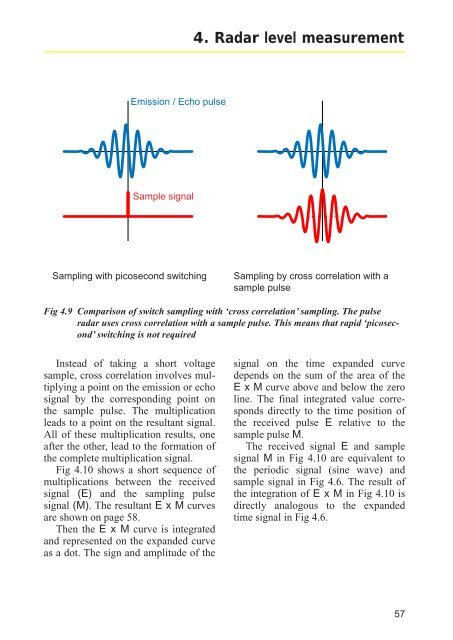Radar level measurement Radar level measurement The user's guide
Radar level measurement Radar level measurement The user's guide
Radar level measurement Radar level measurement The user's guide
Create successful ePaper yourself
Turn your PDF publications into a flip-book with our unique Google optimized e-Paper software.
4. <strong>Radar</strong> <strong>level</strong> <strong>measurement</strong>Emission / Echo pulseSample signalSampling with picosecond switchingSampling by cross correlation with asample pulseFig 4.9 Comparison of switch sampling with ‘cross correlation’ sampling. <strong>The</strong> pulseradar uses cross correlation with a sample pulse. This means that rapid ‘picosecond’switching is not requiredInstead of taking a short voltagesample, cross correlation involves multiplyinga point on the emission or echosignal by the corresponding point onthe sample pulse. <strong>The</strong> multiplicationleads to a point on the resultant signal.All of these multiplication results, oneafter the other, lead to the formation ofthe complete multiplication signal.Fig 4.10 shows a short sequence ofmultiplications between the receivedsignal (E) and the sampling pulsesignal (M). <strong>The</strong> resultant E x M curvesare shown on page 58.<strong>The</strong>n the E x M curve is integratedand represented on the expanded curveas a dot. <strong>The</strong> sign and amplitude of thesignal on the time expanded curvedepends on the sum of the area of theE x M curve above and below the zeroline. <strong>The</strong> final integrated value correspondsdirectly to the time position ofthe received pulse E relative to thesample pulse M.<strong>The</strong> received signal E and samplesignal M in Fig 4.10 are equivalent tothe periodic signal (sine wave) andsample signal in Fig 4.6. <strong>The</strong> result ofthe integration of E x M in Fig 4.10 isdirectly analogous to the expandedtime signal in Fig 4.6.57



